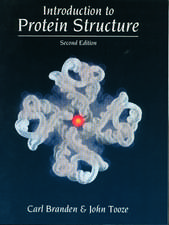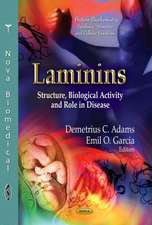Computational Biology of Transcription Factor Binding: Methods in Molecular Biology, cartea 674
Editat de Istvan Ladungaen Limba Engleză Hardback – 13 sep 2010
| Toate formatele și edițiile | Preț | Express |
|---|---|---|
| Paperback (1) | 957.94 lei 6-8 săpt. | |
| Humana Press Inc. – 23 aug 2016 | 957.94 lei 6-8 săpt. | |
| Hardback (1) | 662.16 lei 6-8 săpt. | |
| Humana Press Inc. – 13 sep 2010 | 662.16 lei 6-8 săpt. |
Din seria Methods in Molecular Biology
- 9%
 Preț: 791.63 lei
Preț: 791.63 lei - 23%
 Preț: 598.58 lei
Preț: 598.58 lei - 20%
 Preț: 882.98 lei
Preț: 882.98 lei -
 Preț: 252.05 lei
Preț: 252.05 lei - 5%
 Preț: 802.70 lei
Preț: 802.70 lei - 5%
 Preț: 729.61 lei
Preț: 729.61 lei - 5%
 Preț: 731.43 lei
Preț: 731.43 lei - 5%
 Preț: 741.30 lei
Preț: 741.30 lei - 5%
 Preț: 747.16 lei
Preț: 747.16 lei - 15%
 Preț: 663.45 lei
Preț: 663.45 lei - 18%
 Preț: 1025.34 lei
Preț: 1025.34 lei - 5%
 Preț: 734.57 lei
Preț: 734.57 lei - 18%
 Preț: 914.20 lei
Preț: 914.20 lei - 15%
 Preț: 664.61 lei
Preț: 664.61 lei - 15%
 Preț: 654.12 lei
Preț: 654.12 lei - 18%
 Preț: 1414.74 lei
Preț: 1414.74 lei - 5%
 Preț: 742.60 lei
Preț: 742.60 lei - 20%
 Preț: 821.65 lei
Preț: 821.65 lei - 18%
 Preț: 972.30 lei
Preț: 972.30 lei - 15%
 Preț: 660.49 lei
Preț: 660.49 lei - 5%
 Preț: 738.41 lei
Preț: 738.41 lei - 18%
 Preț: 984.92 lei
Preț: 984.92 lei - 5%
 Preț: 733.29 lei
Preț: 733.29 lei -
 Preț: 392.60 lei
Preț: 392.60 lei - 5%
 Preț: 746.26 lei
Preț: 746.26 lei - 18%
 Preț: 962.66 lei
Preț: 962.66 lei - 23%
 Preț: 860.22 lei
Preț: 860.22 lei - 15%
 Preț: 652.64 lei
Preț: 652.64 lei - 5%
 Preț: 1055.50 lei
Preț: 1055.50 lei - 23%
 Preț: 883.87 lei
Preț: 883.87 lei - 19%
 Preț: 491.89 lei
Preț: 491.89 lei - 5%
 Preț: 1038.86 lei
Preț: 1038.86 lei - 5%
 Preț: 524.16 lei
Preț: 524.16 lei - 18%
 Preț: 2122.34 lei
Preț: 2122.34 lei - 5%
 Preț: 1299.23 lei
Preț: 1299.23 lei - 5%
 Preț: 1339.12 lei
Preț: 1339.12 lei - 18%
 Preț: 1390.26 lei
Preț: 1390.26 lei - 18%
 Preț: 1395.63 lei
Preț: 1395.63 lei - 18%
 Preț: 1129.65 lei
Preț: 1129.65 lei - 18%
 Preț: 1408.26 lei
Preț: 1408.26 lei - 18%
 Preț: 1124.92 lei
Preț: 1124.92 lei - 18%
 Preț: 966.27 lei
Preț: 966.27 lei - 5%
 Preț: 1299.99 lei
Preț: 1299.99 lei - 5%
 Preț: 1108.51 lei
Preț: 1108.51 lei - 5%
 Preț: 983.76 lei
Preț: 983.76 lei - 5%
 Preț: 728.16 lei
Preț: 728.16 lei - 18%
 Preț: 1118.62 lei
Preț: 1118.62 lei - 18%
 Preț: 955.25 lei
Preț: 955.25 lei - 5%
 Preț: 1035.62 lei
Preț: 1035.62 lei - 18%
 Preț: 1400.35 lei
Preț: 1400.35 lei
Preț: 662.16 lei
Preț vechi: 779.02 lei
-15% Nou
Puncte Express: 993
Preț estimativ în valută:
126.74€ • 137.72$ • 106.53£
126.74€ • 137.72$ • 106.53£
Carte tipărită la comandă
Livrare economică 19 aprilie-03 mai
Preluare comenzi: 021 569.72.76
Specificații
ISBN-13: 9781607618539
ISBN-10: 1607618532
Pagini: 454
Ilustrații: XI, 454 p.
Dimensiuni: 178 x 254 x 30 mm
Greutate: 1.02 kg
Ediția:2010
Editura: Humana Press Inc.
Colecția Humana
Seria Methods in Molecular Biology
Locul publicării:Totowa, NJ, United States
ISBN-10: 1607618532
Pagini: 454
Ilustrații: XI, 454 p.
Dimensiuni: 178 x 254 x 30 mm
Greutate: 1.02 kg
Ediția:2010
Editura: Humana Press Inc.
Colecția Humana
Seria Methods in Molecular Biology
Locul publicării:Totowa, NJ, United States
Public țintă
Professional/practitionerCuprins
An Overview of the Computational Analyses and Discovery of Transcription Factor Binding Sites.- Components and Mechanisms of Regulation of Gene Expression.- Regulatory Regions in DNA: Promoters, Enhancers, Silencers, and Insulators.- Three-Dimensional Structures of DNA-Bound Transcriptional Regulators.- Identification of Promoter Regions and Regulatory Sites.- Motif Discovery Using Expectation Maximization and Gibbs’ Sampling.- Probabilistic Approaches to Transcription Factor Binding Site Prediction.- The Motif Tool Assessment Platform (MTAP) for Sequence-Based Transcription Factor Binding Site Prediction Tools.- Computational Analysis of ChIP-seq Data.- Probabilistic Peak Calling and Controlling False Discovery Rate Estimations in Transcription Factor Binding Site Mapping from ChIP-seq.- Sequence Analysis of Chromatin Immunoprecipitation Data for Transcription Factors.- Inferring Protein–DNA Interaction Parameters from SELEX Experiments.- Kernel-Based Identification of Regulatory Modules.- Identification of Transcription Factor Binding Sites Derived from Transposable Element Sequences Using ChIP-seq.- Target Gene Identification via Nuclear Receptor Binding Site Prediction.- Computing Chromosome Conformation.- Large-Scale Identification and Analysis of C-Proteins.- Evolution of cis-Regulatory Sequences in Drosophila.- Regulating the Regulators: Modulators of Transcription Factor Activity.- Annotating the Regulatory Genome.- Computational Identification of Plant Transcription Factors and the Construction of the PlantTFDB Database.- Practical Computational Methods for Regulatory Genomics: A cisGRN-Lexicon and cisGRN-Browser for Gene Regulatory Networks.- Reconstructing Transcriptional Regulatory Networks Using Three-Way Mutual Information and Bayesian Networks.-Computational Methods for Analyzing Dynamic Regulatory Networks.
Recenzii
From the reviews:
“Gives us an overview of transcription and its regulation. … The methods are very up-to-date and clearly presented by authors … . The use of tools for predicting transcription factors binding sites is also very carefully presented in a text that is accessible for beginners … . In summary, this book presents an important tool for entering the growing field of bioinformatics and its use for the study of transcription. … If we cannot read all books ever written, this one is a good choice.” (Carla Columbano Oliveira, Brazilian Journal of Pharmaceutical Sciences, Vol. 47 (2), Summer, 2011)
“Gives us an overview of transcription and its regulation. … The methods are very up-to-date and clearly presented by authors … . The use of tools for predicting transcription factors binding sites is also very carefully presented in a text that is accessible for beginners … . In summary, this book presents an important tool for entering the growing field of bioinformatics and its use for the study of transcription. … If we cannot read all books ever written, this one is a good choice.” (Carla Columbano Oliveira, Brazilian Journal of Pharmaceutical Sciences, Vol. 47 (2), Summer, 2011)
Textul de pe ultima copertă
Through great experimental difficulty, we’ve witnessed rapid, crucial developments at the intersection of computational biology, experimental technology, and statistics through which the vital process of transcriptional regulation can be further examined. In Computational Biology of Transcription Factor Binding, experts in the field examine the basic principles and provide detailed guidance for the computational analyses and biological interpretations of transcription factor binding, while disclosing critical practical information and caveats that are missing from many research publications. The volume serves not only computational biologists but experimentalists as well, who may want to better understand how to design and execute experiments and to communicate more effectively with computational biologists, computer scientists, and statisticians. Written for the highly successful Methods in Molecular Biology™ series, this work provides the kind of detailed description and implementation advice that is crucial for getting optimal results in the lab.Authoritative and easy to use, Computational Biology of Transcription Factor Binding guides scientists working in this area and demands not only new experiments but also the re-annotation of existing experimental data and computational predictions leading to important ongoing, major paradigm changes for us all.
Caracteristici
Guides scientists of all disciplines through the jungle of regulatory regions, ChIP-seq, about 200 motif discovery tools and others Includes vital tricks-of-the-trade from experts well-versed in the technology whenever available Provides cutting-edge protocols for computer biologists and for researchers who wish to better communicate with them Includes supplementary material: sn.pub/extras













